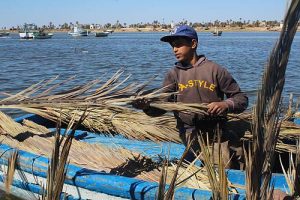 © Institut National du Patrimoine, Tunisie, 2019
© Institut National du Patrimoine, Tunisie, 2019
La charfiya es una técnica tradicional de pesca pasiva que fue inscrita en la Lista Representativa del Patrimonio Cultural Inmaterial de la Humanidad de la UNESCO en 2020.
Esta técnica se practica en las Islas Kerkennah (costa de Túnez). El sistema se basa en aprovechar las condiciones hidrográficas, las características del relieve del fondo del mar y los recursos naturales, que pueden ser tanto terrestres como marinos. De esta manera, se crea una instalación pesquera fija, utilizando una barrera triangular construida a partir de palmas clavadas en el fondo del mar.
Cuando el agua de la marea desciende, los peces son arrastrados, primero en cámaras de captura y luego en redes o nasas. A diferencia de otras técnicas de pesca como las de arrastre que necesitan rascar el lecho marino, los peces capturados con esta técnica permanecen vivos dentro de las redes hasta el momento de izarlas.
La charfiya sólo se instala y se usa desde el equinoccio de otoño hasta el mes de junio para poder dar reposo a los recursos, facilitando así, su regeneración.
Esta técnica y su instalación viene acompañada de un gran patrimonio inmaterial que consiste en la celebración de comidas en común y recitales de plegarias. El conocimiento relacionado con esta técnica abarca desde la topografía submarina hasta las corrientes marinas. Gran parte de los habitantes aprenden a pescar desde la infancia. También existen centros de formación profesional donde se puede adquirir un aprendizaje indirecto de este patrimonio cultural inmaterial.
Visualiza el vídeo realizado por L’Institut National du Patrimoine (Tunisie) pinchando aquí.
__
THE CHARFIYA: TRADITIONAL PASSIVE FISHING TECHNIQUE
The charfiya is a traditional passive fishing technique that was inscribed on UNESCO’s Representative List of the Intangible Cultural Heritage of Humanity in 2020.
This technique is practiced in the Kerkennah Islands (Tunisian coast). The system is based on taking advantage of hydrographic conditions, the characteristics of the relief of the seabed and natural resources, which can be both terrestrial and marine. In this way, a fixed fishing installation is created, using a triangular barrier built from palms driven into the seabed.
When the tidal water recedes, the fish are hauled in, first in catch chambers and then in nets or pots. Unlike other fishing techniques such as trawling that require scraping the seabed, the fish caught with this technique remain alive inside the nets until they are hauled up.
The charfiya is only installed and used from the autumn equinox until June in order to give the resources a rest, thus facilitating their regeneration.
This technique and its installation is accompanied by a great intangible heritage that consists of the celebration of communal meals and recitals of prayers. The knowledge related to this technique ranges from underwater topography to marine currents. Most of the inhabitants learn to fish since childhood. There are also vocational training centers where one can learn indirectly about this intangible cultural heritage.
Watch the video made by L’Institut National du Patrimoine (Tunisie) by clicking here.
__

